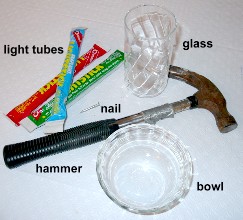
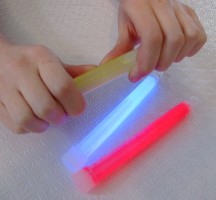 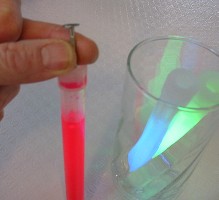 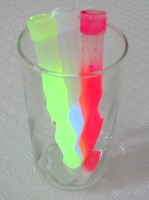 Crack all three tubes and allow a few minutes for them to get bright. Use the nail and hammer to punch two holes in the end of each tube. (A second hole allows the fluid to come out more easily). The glass is used to stand them up so they don't spill. Although the liquid inside the tubes is non-toxic, it will stain, so you'll need to be careful of your clothing. Also you don't want to get it in your eyes ... you should wear goggles. 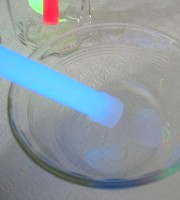
Now you're going to mix the colours together to produce white light. Different brands of light tubes probably have different colour strengths, so you'll have to experiment. We found the blue to be very weak, so we started with about 15 drops in the bowl. The liquid seems to evaporate quite quickly, especially as you slosh it around to mix it, so you'll need to move right along ... try adding 3 or 4 drops of green next. Finally, add a single drop of red and give the mixture a thorough stirring. 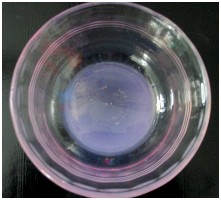 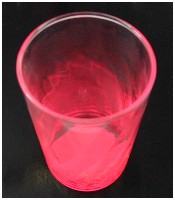
We found that we obtained a mixture which glows with pure white light. You can see our result in the photo at the left. Although it seems a little blue in the picture, it was quite obviously white to the eye. We also wondered about the colour blue being so weak, while red is so strong. The glass at the right shows an equal mixture of all three colours, clearly dominated by red. We'd already noticed this phenomenon with blue Christmas lights on our house that were invisible from the road. Yet police lights are often blue! Find out why blue lights often seem so dim at a distance here. For Teachers: This method for demonstrating that white light can be made by combining other colours is simple and convincing, but it's quite expensive. The tubes came two to a package, for about $6.50, so the experiment cost us close to $20. However, the six tubes we purchased could quite easily have been sufficient for a class of 30 students working in groups of 2. The idea for this demonstration came from "See For Yourself ... More Than 100 Experiments for Science Fairs and Projects", by Vicki Cobb (Scholastic Reference), a highly recommended science idea book for grades 5 through 9. |
